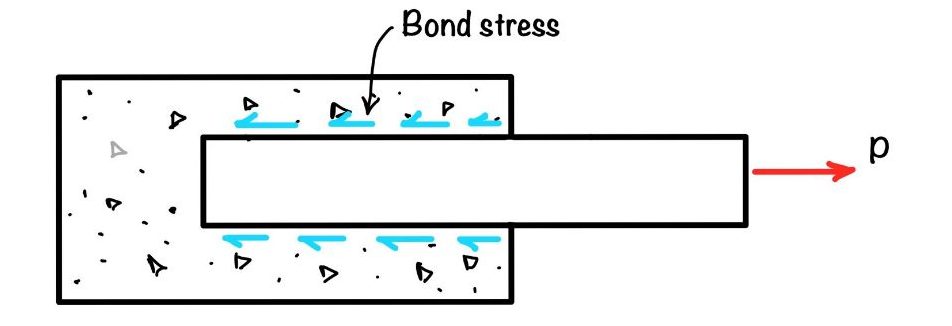Bond stress plays a crucial role in the behavior of R.C.C. structures. It refers to the force per unit area acting on the bond interface between the steel and the adjacent concrete. Understanding the factors that affects the development of bond stress is imp. to estimate the strength and durability of concrete structures.
For instance, when we design R.C.C. structures such as buildings and bridges, engineers must consider the bond stress between the steel and the concrete to ensure structural stability and safety. Moreover, in the construction process, the bond stress determines the quality of the bond, and the overall structural integrity.
Bond stress is due to the force that forms between concrete and bars in an R.C.C. member. It is the stress between the steel and concrete surfaces. When steel is embedded in concrete, it bonds with the nearby material, creating stress. It is important for the strength and stability of a concrete structure. Insufficient bond stress can lead to failure, causing cracks and other damage.

Thus, the bond between steel and concrete must be perfect under service loads. To ensure the integrity and durability of the structure, it is important to carefully calculate and maintain the bond stress between the steel and the concrete.
What is bond stress?
Bond stress is a term used to describe the force per unit area acting on the bond induced between steel and the adjacent concrete in a R.C.C. structure. This force is generated when the steel attempts to move or slip within the concrete. Understanding what bond stress is and how it works is crucial in ensuring the durability and safety of the structure.
Engineers use bond stress calculations to predict the load carrying capacity of R.C.C. structures, such as buildings, bridges, and tunnels.
Factors that influence the bond stress are as follows:
- Surface area of the steel: The larger the surface area of the steel, the greater the bond stress developed between the steel and the concrete.
- Type and texture of the concrete: The type and texture of the concrete can affect the bond stress.
- Presence of corrosion on the steel surface: Any corrosion on the surface of the steel can reduce the bond strength between the steel and the concrete, leading to lower bond stress.
- Size and shape of the steel: The size and shape of the steel can affect the bond stress. Larger dia. steel bars or bars provide more surface area for bonding with the concrete and therefore, can result in higher stress.
- Age of the concrete: The bond stress can increase with time as the concrete sets and hardens, due to the development of stronger adhesion between the steel and the concrete.
What are the factors that affect development of bond stress
The development of bond stress between steel and concrete in a R.C.C. structure is influenced by various factors.
Some of the factors that affects the development of bond stress are:
- Pure adhesion: It is due to gum like property of materials produced in concrete during the hydration of cement.
- Frictional resistance: The resistance between steel and concrete is an essential factor to calculate the bond stress in R.C.C. structures. Frictional resistance is the force that opposes the relative movement between the steel and the adjacent concrete.
- Mechanical resistance: Due to deformation of the bar. The bond resistance of a plain bar is due to adhesion and friction between concrete and steel, and that of the deformed bar is due to mechanical resistance in addition to adhesion and frictional resistance.
Different types of bond
In R.C.C. structures, there are several types of bonds that can develop between the steel and the near by concrete.
Different types of bonds are:
- Mechanical bond: This bond is created through the use of bars, which have surface defects such as ridges that provide better adhesion and friction with the adjacent concrete.
- Adhesive bond: This bond is created through the use of adhesive materials, such as epoxy or resin, applied to the surface of the steel before it is embedded in the concrete. The adhesive material enhances the bond between the steel and the concrete.
- Friction bond: This bond is created by the frictional resistance between the steel and the concrete, resulting from the pressure exerted by the concrete on the steel surface.
- Flexural bond: It develops along the length of a bar in order to let the concrete and steel act together.
- Anchorage bond: It develops in the anchorage zone at the ends of the bar or at the cut-off point of a bar within a span of the beam so that bars are not pulled out.
Conclusions
In this post, the different factors that influence the bond stress between steel bar and concrete in an R.C.C structure are discussed.
The key findings from the blog are as follows:
- Bond stress: Surface preparation of the steel and the concrete surface is essential for improving the bond stress. Concrete quality, including its strength, texture, and porosity, can affect bond stress.
- The age of the concrete: It is a critical factor in the development of bond stress, as the bond strength can increase over time as the concrete sets and hardens.
- The type of bond: The bond between the steel and the concrete, including adhesive, and friction bonds, can also affect the bond stress.
In conclusion, the development of bond stress is a complex process that gets influenced by various factors. It is crucial to ensure that the bond stress is carefully calculated to ensure the durability and stability of an R.C.C. structure.
This article was crafted by a group of experts at eigenplus to ensure it adheres to our strict quality standards. The individuals who contributed to this article are:
Author

This article was crafted by a group of experts at eigenplus to ensure it adheres to our strict quality standards. The individuals who contributed to this article are:
Author

This article was crafted by a group of experts at eigenplus to ensure it adheres to our strict quality standards. The individuals who contributed to this article are:
Author


